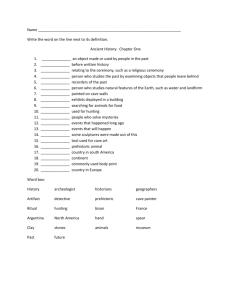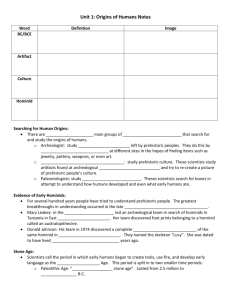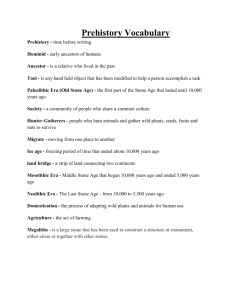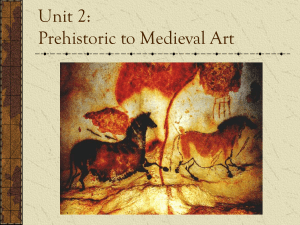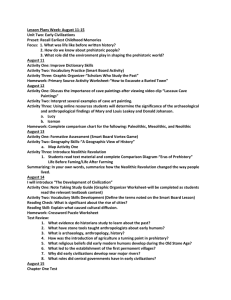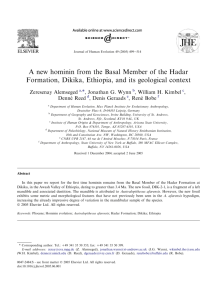Unit 2 Interactive Notebook
advertisement
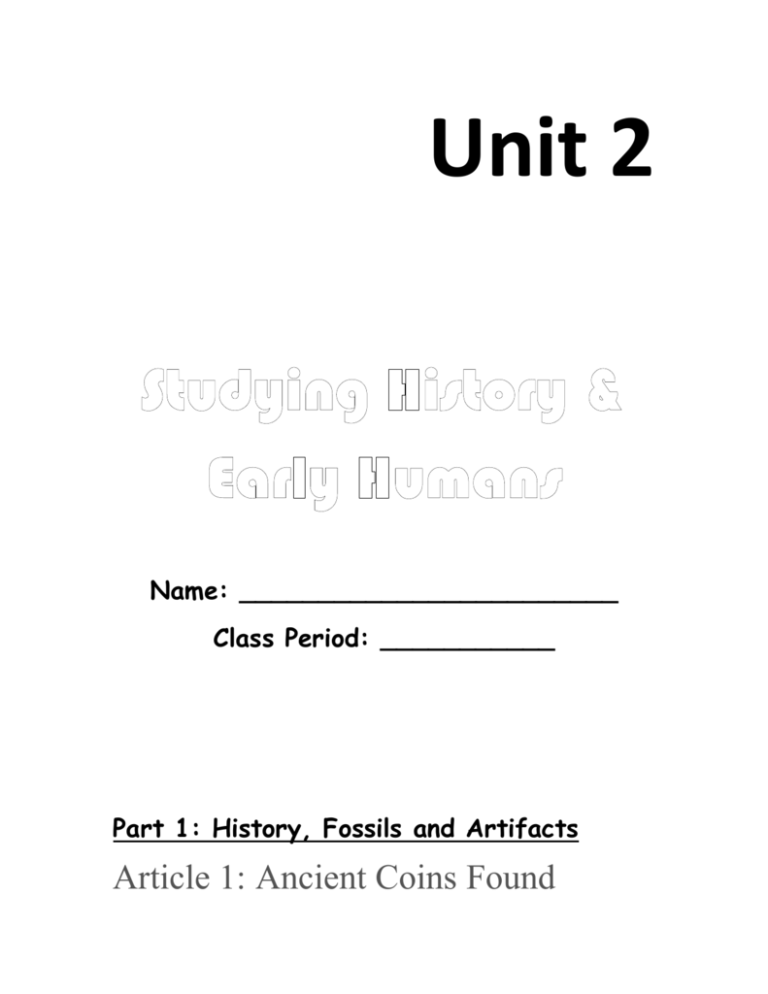
Unit 2 Name: ________________________ Class Period: ___________ Part 1: History, Fossils and Artifacts Article 1: Ancient Coins Found Buried in British Cave By Kelly Dickerson, Staff Writer | July 11, 2014 12:48pm ET Digging through a cave in central Britain, archaeologists uncovered 26 ancient gold and silver coins belonging to the Corieltauvi tribe, a group of people that lived in Britain before the Roman conquest. An excavation at Reynard's Kitchen Cave in the UK unearthed 26 coins from the Iron Age and Roman period. Credit: Richard Davenport Photography Archaeologists previously found collections of coins like these in other parts of Britain, but this is the first time they have ever been discovered buried in a cave. The discovery of the coins was a surprise, because they were found at a site called Reynard's Kitchen Cave, which is located outside the Corieltauvi's usual turf. "It might be that we have a member of the tribe living beyond the boundary that is more usually associated with the territory," Rachael Hall, an archaeologist at the National Trust who led the excavation, told Live Science in an email. Article 2: Tooth Tales: Prehistoric Plaque Reveals Early Humans Ate Weeds 2 By Laura Geggel, Staff Writer | July 16, 2014 02:23pm ET Researchers studied the dental calculus of skeletons, such as this one of a young man, found at a prehistoric gravesite in central Sudan. Credit: Donatella Usai/Centro Studi Sudanesi and Sub-Sahariani (CSSeS) When looking for a meal, prehistoric people in Africa munched on the tuberous roots of weeds such as the purple nutsedge, according to a new study of hardened plaque on samples of ancient teeth. Researchers examined the dental buildup of 14 people buried at Al Khiday, an archeological site near the Nile River in central Sudan. The skeletons date back to between about 6,700 B.C., when prehistoric people relied on hunting and gathering, to agricultural times, at about the beginning of the first millennium B.C. The researchers collected samples of the individuals' dental calculus, the hardened grime that forms when plaque accumulates and mineralizes on teeth. Such buildup is fairly common in prehistoric skeletons, the researchers said. Complete the table below from the information you read in the two articles on pages 2 & 3. QUESTION Article 1 Article 2 What did 3 archaeologists/ researchers discover? What was learned from this discovery? What clues were given to support the researchers to come to this conclusion? A fossil is a part or imprint of something that was once alive, typically in some kind of rock or imprinted in material such as amber. An artifact is an object left behind that was created and used by humans. Knowing the difference between fossils and artifacts, which was found in these articles. Circle the correct answer next to the article. Article 1 fossils artifacts Article 2 fossils artifacts MAKE A CONNECTION! How do historians use fossils and artifacts to tell the stories of ancient people? Write a 3-5 sentence paragraph. Use examples to better explain your points. You may refer to the articles if needed. _______________________________________________________ _______________________________________________________ 4 _______________________________________________________ _______________________________________________________ _______________________________________________________ _______________________________________________________ _______________________________________________________ _______________________________________________________ PAGES 6 – 11 are taken from the Holt World History text. As you read—ANNOTATE and INTERACT with the text. ASKING QUESTIONS--PRE-READING: Look at headings, captions, pictures. Predict what the text will tell you. UNDERLINE key vocabulary terms and their definitions. CIRCLE unfamiliar words. SUMMARIZE very important points in the margins. History vs. Archaeology CREATE a graphic organizer in the blank space below that illustrates the difference between HISTORY and 5 ARCHAEOLOGY. You may choose to do a Top Hat, Venn Diagram, T-Chart, or other visual. You MUST include what makes each study different, examples of what they may study, and ways in which they are similar. From the information on Page 8, we know that studying history helps us understand THREE things: 1. 6 2. 3. In what ways does history help us know ourselves? In what ways does history help us understand others? In what ways does history help us know our world? APPLY IT: “Why do I need to study history?” As a young person studying history, how might you explain to someone who doesn’t see the value of history why it is important to understand the events of the past. Make sure to support your reasoning to make your argument strong! _____________________________________________________________ _____________________________________________________________ _____________________________________________________________ _____________________________________________________________ _____________________________________________________________ Name ___________________________________ Class Period _______ STUDYING HISTORY FORMATIVE! Remove this sheet from your packet. 7 Answer the following questions by circling the BEST answer. 1. The tablet shown above with ancient writing is an example of _______________. a. a primary source and an artifact b. a primary source and a fossil c. a secondary source and an artifact d. a secondary source and a fossil. 2. Which of the following is the BEST reason to explain why we study history? a. We can learn the dates of important events. b. We can learn interesting facts about famous people. c. We can learn about ourselves and other people. d. We can hear stories about strange things. 3. Which of the following would an archaeologist find most interesting? a. Writings about a battle during the Civil War b. An ancient tool used to hunt buffalo c. Oceans that influence weather patterns d. The shift of the continents over time 4. Which of the following is an example of a primary source? 8 a. b. c. d. A journal entry from a young bride traveling west An article from a current encyclopedia Data on weather and climate A book about the people of ancient China 5. . If a historian writes his or her own opinion, this is an example of a a. b. c. d. A primary source A secondary source An encyclopedia article An artifact 6. How does history help citizens around the world know their own countries better? a. It teaches people about their past. b. It teaches people how their government came into existence. c. It acknowledges their triumphs and tragedies. d. It teaches all of the above. 7. Which of the following would a historian be least interested in? a. the bones of a group of people b. the knowledge of a group of people c. the beliefs of a group of people d. the customs of a group of people PART 2: 9 STONE AGES & EARLY CULTURES The First People Lucy - the most complete skeleton Australopithecus afarensis is known from many fossil finds in Tanzania, Kenya and Ethiopia, but Lucy is particularly important because she is the most complete and well-preserved afarensis fossil ever found. Unearthed in 1974, around 40% of her full skeleton was recovered, making her the most complete skeleton of an early human relative known at the time. This relative completeness helped scientists begin to understand how early human-like species walked on 2 legs (bipedally). Ape-like characteristics The brain size of A. afarensis was ape-like, and there is no evidence so far of tool-making. A. afarensis was evidently similar to living apes in terms of diet, aspects of biology, growth and development. Habitat and way of life The habitat of A. afarensis was probably a mix of woodland, where they foraged for food on the ground and in trees, along with more open areas where they would have walked upright. Evidence from their teeth suggest that this hominid ate soft fruits and leaves but was also adapted to eat harder, more brittle foods too. Australopithecus afarensis fossils are providing us with vital clues as to what hominid life was like after upright walking emerged and before the use of tools transformed human evolution. Based on this article, what do scientists believe Lucy was able to do? What was she NOT able to do? Make a chart in the space below. Lucy lived in the time of known as prehistory. This is the time before writing existed. Since writing has only been 10 around for 5,000 years, there is much of history that isn’t recorded. Lucy is known as a hominid. Scientists believe that hominids are early ancestors of humans. An ancestor is a relative who lived in the past. There are a number of different hominids scientists believe existed over the course of prehistory. Complete the graphic organizer below. From the information you read on the following pages. Homo habilis Homo erectus The First Tools Homo sapiens Later Tools 11 DESCRIBE the first tools. Where were they found? How were they made? What material were later tools made from? Why was this material used? For what purposes were these later tools used? What do scientists believe the first tools were used for? What was the benefit of adding wooden handles to later tools? Explain. 12 Read the sections on “Hunter-gatherer Societies” and “Society” from the text. From the word bank below, match the term or terms with the BEST description [cave] [women] [groups] [food] [society] [seeds] [cliffs] [collecting] [fruits] [culture] [water] [children] [safer] [nuts] [plants] [hunter-gatherers] [men] A _____________________ is a community of people who share a common _____________________________. Early humans lived in small groups. In bad weather, they might have taken shelter in a ________________________ if it was nearby. If __________________ or ___________________ are hard to find, groups of people would move to new areas. Early humans of the Stone Age were _____________________________________. Hunter-gatherers hunt animals and gather _______________________, ______________________, _______________________, and ___________________________ in order to survive. Anthropologists believe that hunters in the Stone Age were ______________. They hunted in _________________________. Sometimes, they would chase animals off a ______________________! This was much _________________ than hunting alone. ___________________________ in hunter-gatherer societies probably took on the role of ________________________________ plants, staying near the camp, and taking care of ______________________________________. 13 Language, Art, & Religion List THREE reasons scientists believe language developed. 1. 2. 3. ART is another way early people expressed themselves. What did early people carve figures out of? Where would early people paint pictures of people and animals? What are two THEORIES scientists have about why early people made paintings? 1. 2. What was discovered that would suggest early people had some kind of religious beliefs? 14 THE PATH OF MIGRATION Reading “People Move Out Of Africa,” “The Ice Ages,” and “Settling New Lands.” As you read, complete the chart to describe the SEQUENCE of events as people moved out of Africa during the Ice Ages and settled in new areas. FIRST THEN THEN THEN THEN THEN 15 THEN Adapting to new environments Complete the bubbles in the space below with details about how early humans adapted to their new environments CLOTHING SHELTER NEW TOOLS TECHNOLOGIES 16 What was the Mesolithic Era? What did people do at this time in history that defines the Mesolithic Era? Summarizing “The Beginnings of Agriculture” For each paragraph, write a one-sentence summary outlining the most important idea in each paragraph in the boxes provided. The First Farmers, par1 The First Farmers, par2 The First Farmers, par3 Plants, paragraph1 Plants, paragraph2 Plants, paragraph3 Plants, paragraph4 Animals, paragraph1 Animals, paragraph2 17 Reading Check 1 What was one EFFECT (result) of the switch to farming? Farming Changes Societies, par1 Farming Changes Societies, par2 Farming Changes Societies, par3 Farming Changes Societies, par 4 Farming Changes Societies, par5 Reading Check How did farming contribute to the growth of towns? Use your summarizing notes to answer the following questions. 1. What is domestication of a plant or animal? 18 2. How did early people use domesticated animals? 3. What were gods or goddesses probably associated with in prehistoric religion? 4. How did the domestication of plants and animals lead to the development of towns? 5. What caused the need to develop agriculture/farming? 6. List THREE effects of the development of agriculture. 19 Vocabulary Term Definition History The study of the past Term Definition Culture The knowledge, beliefs, customs, and values, of a group of people Term Definition Archaeology The study of the past based on what people left behind Term Definition Fossil A part or imprint of something that was once alive Term Definition Artifacts An object created and used by humans Term Definition Primary source An account of an event by someone who took part in or witnessed the event 20 Term Definition Secondary source Information gathered by someone who did not take part in or witness the event Term Definition Prehistory The time before prehistory Term Definition Hominid An early ancestor of humans Term Definition Ancestor A relative who lived in the past Term Definition Tool An object that has been modified to help a person accomplish a task Term Definition Paleolithic Era The first part of the Stone Age (The Old Stone Age); when people first used stone tools Term Definition Society A community of people who share a common culture 21 Term Definition Hunter-gatherers People who hunt animals and gather wild plants, seeds, fruits, and nuts to survive Term Definition Migrate To move to a new place Term Definition Ice ages Long periods of freezing weather Term Definition Land bridge A strip of land connecting two continents Term Definition Mesolithic Era The middle part of the Stone Age; marked by the creation of smaller and more complex tools Term Definition Neolithic Era The New Stone Age; when people learned to make fire and tools such as saws and drills 22 Term Definition Domestication The process of changing plants or animals to make them more useful to humans Term Definition Agriculture Farming Term Definition Megaliths A huge stone monument 23
